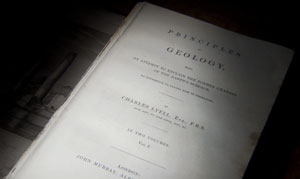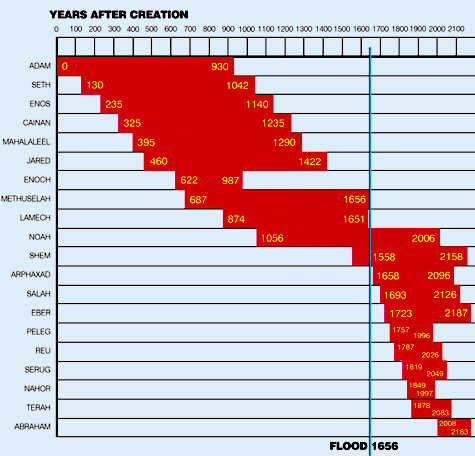
It comes as a surprise to most people to hear that there is abundant evidence that the entire human race came from two people just a few thousand years ago (Adam and Eve), that there was a serious population crash (bottleneck) in the recent past (at the time of the Flood), and that there was a single dispersal of people across the world after that (the Tower of Babel).1 It surprises them even more to learn that much of this evidence comes from evolutionary scientists. In fact, an abundant testimony to biblical history has been uncovered by modern geneticists. It is there for anyone to see, if they know where to look!
For our purposes, the most important places to look are in the Y chromosome (which is only found in males and which is passed on directly from father to son) and in the mitochondrial DNA (a small loop of DNA that we nearly always inherit from our mothers only; males do not pass it on to their children). These two pieces of DNA record some startling facts about our past.
Over the last decade, a vast amount of information has been collected that allows us to answer questions that we could not even consider earlier. The tools of modern genetics allow us to specifically ask questions about history, for our genes carry a record that reflects where we came from and how we got to where we are. The tools at our disposal are powerful.
Creation and genetics
There are two brief passages in the Creation account we can use to draw some conclusions about human genetic history. Please note that we cannot use these verses for land animals (because we do not know how many of each kind were initially created) or any of the swimming critters (“with which the waters abounded”—Gen 1:21). These statements apply to people only:
“And the Lord God formed man out of the dust of the ground, and breathed into his nostrils the breath of life; and the man became a living being.” Gen 2:7
“And the Lord God caused a deep sleep to fall on Adam, and he slept; and he took one of his ribs, and closed up the flesh in its place. Then the rib which the Lord God had taken from the man he made into a woman, and He brought her to the man.” Gen 2:21–22
These simple statements have profound implications. They put a limit on the amount of diversity we should find in people living today. The Bible clearly says the human race started out with two people only. But how different were these two people? There is an intriguing possibility that Eve was a clone of Adam. The science of cloning involves taking DNA from an organism and using it to manufacture an almost perfect copy of the original. Here, God is taking a piece of flesh, with cells, organelles, and, importantly, Adam’s DNA, and using it to manufacture a woman. Of course, she could not be a perfect clone, because she was a girl! But what if God had taken Adam’s genome and used it to manufacture Eve? All he would have had to do was to leave out Adam’s Y chromosome and double his X chromosome and, voilá, instant woman!
I do not know if Eve was genetically identical to Adam. The only reason I bring this up is because we have two possibilities in our biblical model of human genetic history: one original genome or two. Either result is still vastly different from the most popular evolutionary models,2 but we need to discuss the range of possibilities that the Bible allows.
Your genome is like an encyclopedia (almost literally). And, like an encyclopedia, the genome is broken down into volumes, called chromosomes, but you have two copies of each volume (with the exception of the X and Y chromosomes; women have two Xs but men have one X and one Y). Imagine comparing two duplicate volumes side by side and finding that one word in a particular sentence is spelled differently in each volume (perhaps “color” vs “colour”). Can you see that if Eve was a clone of Adam, there would have been, at most, two possible variants at any point in the genome? If Eve was not a clone, however, there would have been, at most, four possible variants at any point in the genome (because each of the original chromosomes came in four copies). This still allows for a lot of diversity overall, but it restricts the variation at any one spot to 2, 3, or 4 original readings.
Does this fit the evidence? Absolutely! Most variable places in the genome come in two versions and these versions are spread out across the world. There are some highly variable places that seem to contradict this, but most of these are due to mutations that occurred in the different subpopulations after Babel.
There are indications, however, that Eve may not have been a clone. The ABO blood group is a textbook example of a gene with more than two versions.3 There are three main versions of the blood type gene (A, B, and O). However, many, but not all, people with type O blood carry something that looks very much like a mutant A (the mutation prevents the manufacturing of the type A trait on the outside of cells). So here is a gene with more than two versions, but one of the main versions is clearly a mutation. This is true for many other genes, although, as usual, there are exceptions. The important take home point is that essentially all of the genetic variation among people today could have been carried within two people, if you discount mutations that occurred after our dispersion across the globe. This is a surprise to many.
The Flood and genetics
Like in the Creation story, there are only a few verses in the Flood account that help us with our model. But as seen before, these verses are profound.
Like in the Creation story, there are only a few verses in the Flood account that help us with our model. But as seen before, these verses are profound. About 10 generations after Creation, a severe, short bottleneck occurred in the human population. From untold numbers of people, the entire world population was reduced to eight souls with only three reproducing couples.
“So Noah, with his sons, his wife, and his sons’ wives, went into the ark because of the waters of the flood.” Gen 7:7
“Now the sons of Noah who went out of the ark were Shem, Ham, and Japheth… These three were the sons of Noah, and from these the whole earth was populated.” Gen 9:18–19
We can draw many important deductions from these statements. For instance, based on Genesis 7 and 9, how many Y chromosomes were on the Ark? The answer: one. Yes, there were four men, but Noah gave his Y chromosome to each of his sons. Unless there was a mutation (entirely possible), each of the sons carried the exact same Y chromosome. We do not know how much mutation occurred prior to the flood. With the long life spans of the antediluvian patriarchs, it may be reasonable to assume little mutation had taken place, but all of Creation, including the human genome, had been cursed, so it may not be wise to conclude that there was no mutation prior to the Flood. The amount of mutation may be a moot point, however, for, if it occurred, the Flood should have wiped out most traces of it (all of it in the case of the Y chromosome).
How many mitochondrial DNA lineages were on the Ark? The answer: three. Yes, there were four women, but the Bible does not record Noah’s wife as having any children after the Flood (in this case, girl children). And notice the claim in Gen 9:19, “These three were the sons of Noah, and from these the whole earth was populated.” This is a strong indication that Noah’s wife did not contribute anything else to the world’s population. With no prohibition against sibling marriage, yet,4 one or more of the daughters-in-law may have been her daughter, but this does not change the fact that, at first glance, we expect a maximum of three mitochondrial lineages in the current world population. There is a chance that there will be less, if there was very little mutation before the Flood or if several of the daughters-in-law were closely related. At most, we do not expect more than four.
How many X chromosome lineages were on the Ark? That depends. If you count it all up, you get eight. If, by chance, Noah’s wife passed on the same X chromosome to each of her three sons (25% probability), then there were seven. If Noah had a daughter after the Flood (not expected, but possible), there could be as many as nine X chromosome lineages. Either way, this is a considerable amount of genetic material. And since X chromosomes recombine (in females), we are potentially looking at a huge amount of genetic diversity within the X chromosomes of the world.
Does this fit the evidence? Absolutely! It turns out that Y chromosomes are similar worldwide. According to the evolutionists, no “ancient” (i.e., highly mutated or highly divergent) Y chromosomes have been found.5 This serves as a bit of a puzzle to the evolutionist, and they have had to resort to calling for a higher “reproductive variance” among men than women, high rates of “gene conversion” in the Y chromosome, or perhaps a “selective sweep” that wiped out the other male lines.6 For the biblical model, it is a beautiful correlation and we can take it as is.
The evidence from mitochondrial DNA fits our model just as neatly as the Y chromosome data. As it turns out, there are three main mitochondrial DNA lineages found across the world. The evolutionists have labeled these lines “M”, “N”, and “R”, so we’ll refer to them by the same names. They would not say these came off the Ark. They claim they were derived from older lines found in Africa, but this is based on a suite of assumptions (I discussed these in detail in a recent article in the Journal of Creation7). It also turns out that M, N, and R differ by only a few mutations. This gives us some indication of the amount of mutation that occurred in the generations prior to the Flood.
Let’s assume ten female generations from Eve to the ladies on the Ark. M and N are separated by about 8 mutations (a small fraction of the 16,500 letters in the mitochondrial genome). R is only 1 mutation away from N. This is an indication of the mutational load that occurred before the Flood. Given the assumption that mutations occur at equal rates in all lines, about four mutations separate M and N each from Eve (maybe four mutations in each line in ten generations). But what about R? It is very similar to N. Were N and R sisters, or perhaps more closely related to each other than they were to M? We’ll never know, but it sure is fascinating to think about.
One more line of evidence crops up in the amount of genetic diversity that has been found within people worldwide. Essentially, much less has been found than most (i.e., evolutionists!) predicted. The general lack of diversity among people is the reason the Out of Africa model has humanity going through a disastrous, near-extinction bottleneck with only about 10,000 (and perhaps as few as 1,000)8 people surviving. However, the reason for this lack of diversity is twofold. First, the human race started out with only two people. Second, the human race is not that old and has not accumulated a lot of mutations, despite the high mutation rate. Third, there actually was a bottleneck event, Noah’s Flood!
The Tower of Babel and genetics
The Tower of Babel has been a favorite bedtime story for generations. But is it more than a fairy tale? Could it be possible that there is evidence to back up this tale of rebellion and judgment? Like the Creation and Flood accounts, there are only a couple of verses that apply to our model of genetics. But, like the others, these verses are as profound as they are simple.
“Now the whole earth had one language and one speech.” Gen 11:1
“And they said, ‘Come, let us build ourselves a city, and a tower whose top is in the heavens; let us make a name for ourselves, lest we be scattered abroad over the face of the whole earth.’” Gen 11:4
It sounds like they were in a homogenous culture, but what do people in that situation do? Would you expect them to mix freely? Were language or cultural barriers present that would have prevented the sons of Shem from marrying the daughters of Japheth? Would the daughters of Ham be expected to marry freely with the sons of any of the three men? Note in Gen 11:4 that they knew about the potential for spreading out and getting separated from one another and intentionally did the opposite! However, this was against the express command of God, who had ordered them to spread out (to populate the earth). So, He took matters into His own hands.
“’Come, let Us go down and confuse their language, that they may not understand one another’s speech.’ So the Lord scattered them abroad from there over the face of all the earth, and they ceased building the city.” Gen 11:7–8
There are tremendous implications that come from the Babel account. First it explains the amazing cultural connectivity of ancient peoples—like pyramid building, common flood legends, and ancient, non-Christian genealogies that link people back to biblical figures (e.g., many of the royal houses of pagan northern Europe go back to Japheth, the son of Noah9).
The dramatic rise in world population over the past several decades is a well known fact. From a biblical perspective, the current human population easily fits into the standard model of population growth using very conservative parameters.10 In fact, starting with 6 people and doubling the population every 150 years more than accounts for the current human population (a growth rate of less than 0.5% per year!). Population size would have increased quickly given the rate at which the post-Flood population reestablished agriculture, animal husbandry, industry and civilization. So we must ask the question, “Why are there so few people in the world today?” The answer is that the world is young and we have not been here many thousands of years.
When did the dispersion occur? Our best clue about the timing of the event comes from Genesis 10:25. In referencing the 5th generation descendent of Shem, a man named Peleg, it says, “in his days the earth was divided.” To what is this referring? Many people believe this is referring to a division of the landmasses (plate tectonics). This may be true, but it would require a huge amount of geologic activity after the Flood, and this would have occurred in historical times with no record of the events. The interpretation I favor is that this passage is referring to the division of people at Babel. Just a few verses after the Peleg reference, the section is summed up with another reference to the division at Babel. This fits both the context and the science. In context, Peleg was closely associated with Babel.
How large was the population at the time? We would expect rapid population growth, but we cannot know exactly. There are 16 named sons born to the three brothers, Shem, Ham and Japheth. If we assume about the same number of daughters, Noah had on the order of 30 grandchildren. At that rate of growth, there would have been about 150 children in Salah’s generation, about 750 in Eber’s generation, and about 3,750 in Peleg’s generation. Of course, these generations overlap, etc., so let’s say there were between 1,000 and 10,000 people alive at the time of Babel. This fits nicely with the available data. It is a high rate of growth, but wars and disease had yet to start taking their toll.
There is one more verse in this section that we need to discuss:
“These were the families of the sons of Noah, according to their generations, in their nations; and from these the nations were divided on the earth after the flood.” Gen 10:32
At Babel, God did not separate the nations according to language. He used language to separate them according to paternal (male) ancestry! This has monumental significance and is the key to understanding human genetic history.
Do you see the implication in this simple verse? At Babel, God did not separate the nations according to language. He used language to separate them according to paternal (male) ancestry! This has monumental significance and is the key to understanding human genetic history. Paternal sorting would lead to specific Y chromosome lineages in different geographical locations. Since males and females from the three main families should have been freely intermixing prior to this, it also leads to a mixing of the mitochondrial lines. It is as if God put all the people into a giant spreadsheet and hit a button called “Sort According to Father.” He then took that list and used it to divide up and separate the nations.
We already saw that Y chromosomes have little variation among them. We now add the fact that this little bit of variation is almost always geographically specific. That is, after the nations were separated according to Y chromosome, mutations occurred in the various lines. Since the lines were sent to specific geographical areas, the mutations are geographically specific. The current distribution of Y chromosome lines is a tremendous confirmation of the biblical model.
Mitochondrial DNA (mtDNA) adds another confirmation. We have already learned that there are three main lineages of mtDNA. We now add the fact that these three lineages are more or less randomly distributed across the world. Also, the various mutations within each of the three main families of mtDNA are geographically specific as well.11 In other words, as the three mixed mitochondrial lines were carried along with the Y chromosome dispersal, each line in each area began to pick up new mutations, just like we would predict.
After the Flood
The last remaining significant reference in the Bible that will help us build our model of human genetic history is called The Table of Nations. It is found in Genesis chapters 9 and 10. The Table of Nations is a record of the post-Babel tribes, who they descended from, and where they went. If the Bible is an accurate source of history, one might expect to be able to find a significant amount of evidence for the Table of Nations in genetic data. The truth is not that simple, however, and it is important to keep several things in mind. First, the account was written by a person in the Middle East and from a Middle Eastern perspective. It is incomplete in that there are huge sections of the world that are not discussed (sub-Saharan Africa, Northern Europe, Most of Asia, Australia, the Americas, and Oceania). It also reflects a snapshot in time. It was written after the dispersion began, but not necessarily before the dispersion was complete. Indeed, much has changed in the intervening years. People groups have migrated, cultures have gone extinct, languages have changed, separate cultures have merged, etc. The history of man has been full of ebb and flow as people mixed or fought, resisted invasion or were conquered. The history of man since Babel is very complicated. Modern genetics can answer some of the big questions, but answers to many of the smaller details may elude us forever.
This is an important topic for the creation model. The world does not look at the Bible in a favorable light. In fact, it disparages it, sometimes with open hostility. Attacks are often centered on the claim that the Bible is not reliable on historical grounds, and if the history of the Bible is inaccurate, what about the theology? Think about what Jesus told Nicodemus in John 3:12, “If I have told you earthly things and you do not believe, how will you believe if I tell you heavenly things?” Many people today see no history in the Bible; therefore, the spiritual implications are meaningless to them. What would happen for evangelism if the history of the Bible turns out to be true after all?
Related articles
Notes and References
- See Nelson, J.W., Genetics and Biblical demographic events, Journal of Creation [formerly TJ] 17(1):21–23, 2003; http://creation.com/genetics-and-biblical-demographic-events Return to text.
- The most common version of the Out of Africa Theory has people living in Africa (as Homo erectus) for about a million years. Several tens of thousands of years ago (the data varies from author to author), a sudden bottleneck event reduced the population to 10,000 people or less. Modern humans came out of this bottleneck, our population grew and diversified a little, and then we left Africa and colonized the rest of the world. Return to text.
- Criswell D., ABO Blood and Human Origins, Acts & Facts 37(2):10, 2008; ; as well as Sarfati, J., Blood types and their origin (Countering the Critics), Journal of Creation (then called CEN Technical Journal) 11(1):31–32, 1997. Return to text.
- Prohibitions against marrying close relatives were first given in Lev. 18 and 20, about 2,500 years after Creation. Indeed, Abraham, Isaac and Jacob each married close relatives from their own family. Return to text.
- Jobling, M.A., Tyler-Smith, C., The human Y chromosome: an evolutionary marker comes of age, Nature Reviews 4:598–612, 2003. Return to text.
- Garrigan, D. and Hammer, M.F., Reconstructing human origins in the genomic era, Nature Reviews 7:669–680, 2006. Return to text.
- Carter, R.W., The Neutral Model of evolution and recent African origins, Journal of Creation 23(1):70–77, 2009. Return to text.
- Harpending, H.C., et al., The genetic structure of ancient populations, Current Anthropology 34:483, 1993. Return to text.
- A five part series on this subject was printed in the Journal of Creation (then called CEN Technical Journal) in the early 1990s. See Cooper, W.R., The early history of man: Part 1. The table of nations. CEN Tech J 4:67–92, 1990. Return to text.
- Batten, D., Where are all the people? Creation 23(3):52–55, 2001; creation.com/where-are-all-the-people. You can do your own simulation in a spreadsheet program using the formula N = Noekt, where No = the starting population size (6), k = growth rate per year (experiment with different rates and see what happens), and t = time (in years). Return to text.
- Torroni, A., et al., Harvesting the fruit of the human mtDNA tree, TRENDS in Genetics 22(6):339–345, 2006.
source: http://creation.com/noah-and-genetics







.jpg)








